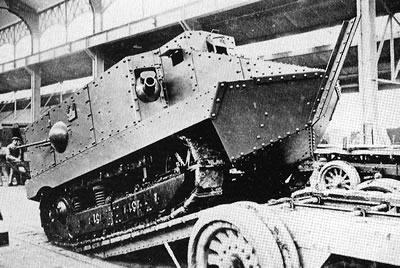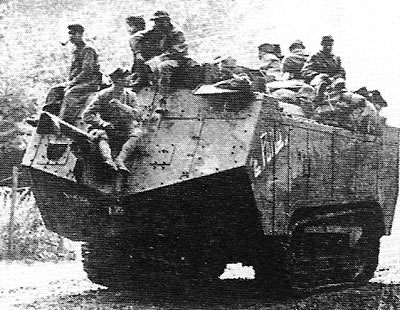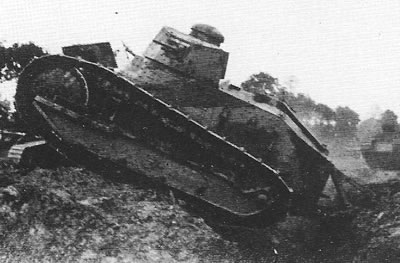
Last updated on February 17th, 2019 at 09:50 pm
After the invention of the tank in Britain, France was developing her own tank designs totally independently of the British, which meant their versions of the tank were quite a bit different. They began in a similar way to the British, developing tracked farm vehicles, but they also gave wheeled tractors a try as well as road rollers. After a while, of course, it became obvious that tracks were the best option and, again like the British at the start, they ordered some test vehicles from America. The Schneider Company bought two Holt tractors from America, not the Killen-Strait like the British, to demonstrate their capabilities in front of artillery officers in the French army. Schneider’s chief engineer, Eugène Brillié, gave orders for an armored body to be fitted to a 45 horsepower Baby Holt tractor, which was put together then tested in December 1915.
 After the initial tests with the mini-tractor it was immediately obvious that a larger machine was required and on December 20th Brillié went to meet Colonel Jean Baptiste Estienne, an artillery officer, who’d been pondering over plans for an armored full-size Holt tractor. Within the next week the two of them had designed the first French tank, the Schneider ‘Char d’Assaut’ (Assault Tank). After two prototypes were tested in trials during February 1915, the Ministry of Armaments ordered four hundred to be built.
After the initial tests with the mini-tractor it was immediately obvious that a larger machine was required and on December 20th Brillié went to meet Colonel Jean Baptiste Estienne, an artillery officer, who’d been pondering over plans for an armored full-size Holt tractor. Within the next week the two of them had designed the first French tank, the Schneider ‘Char d’Assaut’ (Assault Tank). After two prototypes were tested in trials during February 1915, the Ministry of Armaments ordered four hundred to be built.
The first French tank was a Holt tractor with a chassis that had been lengthened and with an armored box fitted on top that had an iron girder fitted to a pointed front to cut through barbed wire. Its weapons included a short 75 mm gun and two Hotchkiss machineguns. The power-plant was a 60hp gasoline engine with a top speed of 5 mph (8 km/h). The entire ensemble weighed 14 tons, half as much as the British tanks, yet still carried six men.
 As a first tank it was in fact rather an elegant-looking machine, similar to Little Willie only with a bit more panache. In fact the new French tank was coveted with no small degree of jealousy from other French industrialists and government departments, so much so that an ‘official tank’ was soon commissioned. The new tank, called the ‘St Chamond’, was similar to the Char d’Assaut apart from everything had been scaled up. The tracks and chassis were the same, but the body was much larger and overhung at the front and back, which gave it less ground-clearance and made it more difficult to drive over very rough terrain. The St Chamond was armed with a 75 mm field gun and four machineguns. The transmission was a gasoline-electric setup that made steering easier but added to the overall weight, which at 29 tons made it more than twice as heavy as its predecessor.
As a first tank it was in fact rather an elegant-looking machine, similar to Little Willie only with a bit more panache. In fact the new French tank was coveted with no small degree of jealousy from other French industrialists and government departments, so much so that an ‘official tank’ was soon commissioned. The new tank, called the ‘St Chamond’, was similar to the Char d’Assaut apart from everything had been scaled up. The tracks and chassis were the same, but the body was much larger and overhung at the front and back, which gave it less ground-clearance and made it more difficult to drive over very rough terrain. The St Chamond was armed with a 75 mm field gun and four machineguns. The transmission was a gasoline-electric setup that made steering easier but added to the overall weight, which at 29 tons made it more than twice as heavy as its predecessor.
Despite its apparent robustness, this heavy tank was actually very temperamental and delicate, often breaking down and leaving its nine crewman stranded. Still, the Ministry of Armaments went ahead and ordered four hundred St Chamond tanks, hoping to use them side by side with the Schneiders already built in a huge surprise attack. It was not until April 1917 when the first French tanks were ready for this first joint attack, which took place with 132 Schneiders at Chemin des Dames on the river Aisne. However, like Little Willie before them, they were not suitable for crossing the German trenches and, like Tank Mark I in battle, were very prone to attacks from artillery and highly combustible with their fuel tanks placed high on the body – so that most of the tanks were destroyed by fire in this first attack, killing or wounding over 170 French crewmen.
Three weeks later it was time to try the St Chamonds for the first time. Sixteen of them trundled into battle with thirty-two Schneiders as backup in an attack at Laffaux Mill. Almost all the St Chamonds became stuck in the mud of the German trenches and the Schneiders performed as before. Each tank behaved in pretty much the same way in subsequent battles and no more of the Char d’Assauts or St Chamonds were ever built, though the few remaining did stay in active service in one form or another throughout the First World War.
 After this, in 1917, the French decided to switch to an entirely new design of tank that was very light and only required two men to operate. The Renault FT 17 was the first tank to have a gun in a fully rotatable turret which, in this case, either had a 37 mm cannon or an 8 mm machinegun. These super-light tanks only weighed 6.5 tons and were designed to be used in huge numbers, like a horde of ants overwhelming their enemy, with an upgraded car engine that gave it a top speed of 6 mph (10 km/h) and a skid at the back to help it cross trenches. Renault kept the cost and weight down by not including any kind of comfort for the crew, with a large front idler made from wood.
After this, in 1917, the French decided to switch to an entirely new design of tank that was very light and only required two men to operate. The Renault FT 17 was the first tank to have a gun in a fully rotatable turret which, in this case, either had a 37 mm cannon or an 8 mm machinegun. These super-light tanks only weighed 6.5 tons and were designed to be used in huge numbers, like a horde of ants overwhelming their enemy, with an upgraded car engine that gave it a top speed of 6 mph (10 km/h) and a skid at the back to help it cross trenches. Renault kept the cost and weight down by not including any kind of comfort for the crew, with a large front idler made from wood.
In May 1918 the Renault FT 17 tank was first sent into battle at Forêt de Retz and thereafter took part in all French fighting during the First World War. In fact this remarkable little machine was still in service with the French Army right up until 1940, a total of three thousand had been produced during the First World War. Like the British ‘Mother’ tank, the FT 17 was adapted for other uses besides being a tank; laying bridges, clearing mines and as a mobile gun platform. Some of the tanks were even produced in America, only 10 by the end of the war but over a thousand in total. The Renault FT 17 was exported all over the globe after the First World War and became the basis of many countries’ first tank designs. Notable tanks of the time based on the FT 17 include the Italian Fiat 3000 and the Russian KS and MS tanks.
